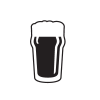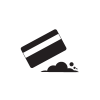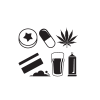What are GHB and GBL?
GHB and GBL are chemicals that are used as medicine (GHB) or for cleaning and other industrial jobs (GBL). People also use them as drugs to give them a buzz and make them feel calm, relaxed, or happy.
Are GHB and GBL the same drug?
GHB and GBL are related but different chemicals. When you take GBL, your body quickly changes it into GHB, which is the drug that affects you. GHB is sometimes given as medicine for narcolepsy, but it's rarely used illegally in the UK.
People started using GHB as a recreational drug in the 1980s and 90s at clubs and parties. Later, people switched to GBL because it was easier to get and felt similar. By the 2000s, most people in the UK had switched to using GBL instead of GHB.
GBL became more popular because it is cheaper, easier to find, and legal for use in cleaning and other jobs. It is found in products such as paint removers, cleaners, and metal cleaners, making it more available than GHB.
If you hear people talking about GHB or using the street names "G" or "Gina," it's safest to think they mean GBL unless you know for sure. GBL is stronger and works faster than GHB, and it's easier to take too much if you get the amount wrong or mix it with alcohol or other drugs that make you sleepy.
In the UK, most recreational use involves GBL (even if you think you've bought GHB). We use "GHB/GBL" in headings for clarity; however, the information on this page primarily refers to GBL.
How does GHB/GBL make you feel?
People report positive effects such as:
- Feeling relaxed or euphoric
- Being more chatty or sociable
- Drowsiness or a sense of calm
But there are also unwanted or risky effects:
- Nausea or vomiting
- Confusion or memory loss
- Loss of coordination
- Passing out, especially if you take too much or mix it with other drugs
How does GHB/GBL affect the brain?
GHB and GBL work by activating the brain's main 'calming' system, known as the GABA system. This slows down brain activity, causing relaxation and sedation. At very high doses, this slowing effect becomes dangerous and can slow vital functions, such as breathing.
How long do the effects of GHB/GBL last?
Both GHB and GBL are drugs that slow you down for a short time. The effects usually start within minutes and last about 2 to 4 hours. GBL often works faster and feels stronger than GHB, but both last about the same time. People sometimes take too much too soon because the effects wear off quickly, which can easily lead to taking too much and overdosing.
Do GHB and GBL smell or taste different?
Yes, they smell, taste, and feel different. These differences can help you figure out which one you've taken.
GHB
- Smell: usually no smell, or faintly sweet.
- Taste: salty or soapy, but not as harsh as GBL.
- Texture: thin and watery. It mixes easily into drinks.
GBL
- Smell: strong, sharp chemical or solvent smell, often like nail polish remover or paint thinner.
- Taste: very bitter, chemical, and unpleasant. Some people describe it as "burning" or "plastic-like."
- Texture: oily and slightly thicker than water.
How do you take GHB/GBL?
GHB and GBL are almost always swallowed. People usually use a syringe or dropper to measure a small amount and then mix it into water, juice, or another soft drink.
Tip: Always dilute pure GBL into water, juice, or another soft drink. Taking it neat will burn your mouth and throat.
Can you overdose on GHB/GBL?
Yes, you can overdose on GBL. GBL is very sensitive to the amount you take. Even small changes in the amount can make a big difference in how it affects you.
These are not recommended doses — they're just here to help you understand the risks:
- Low dose (0.5 to 1 ml): You may feel relaxed, calm, or chatty.
- Moderate dose (1 to 1.5 ml): You'll likely feel heavier, drowsier, or sedated.
- High dose (1.5 ml or more): High risk of vomiting, confusion, unconsciousness, or overdose.
Redosing too soon: Even a small top-up can make you 'G-out'. Wait at least 90 minutes before taking more.
The difference between a dose that makes you feel good and a dose that is too much can be as little as 0.2 to 0.4 mL.
Because the strength of GHB or GBL can vary from one batch to another, the same amount may not have the same effect every time, making it easier to take too much.
Signs of an overdose
- Unresponsive and cannot be woken up.
- Slow, shallow, or irregular breathing (less than 12 breaths per minute).
- Loud, strained snoring or gurgling sounds (this indicates their airway is partially blocked).
- Pale or blue-tinged skin, lips, or fingernails.
- Limp body.
What to do when someone passes out when using GHB/GBL
With GHB or GBL, small amounts might make you feel relaxed or sleepy, but larger amounts can make you suddenly pass out. When you "go under" on G, it is hard to wake you up, and your breathing may slow down or stop. The risks are even higher if you mix G with alcohol, sleeping pills, or other drugs that slow you down.
When someone passes out, they may look like they are sleeping, but they are actually unconscious and hardly respond. Their muscles become loose, which can block their throat and make it hard to breathe. Breathing can get very weak or stop, which can cause choking, brain injury, or death. People may also throw up, wet themselves, or fall somewhere unsafe.
What to do if someone passes out on G:
- Put them in the recovery position (on their side, head tilted back).
- Make sure their airway is clear and keep checking their breathing.
- Don't give them food or drink.
- If they don't wake up quickly, or if you're concerned, call 999 immediately.
- Stay with them even after they wake up. They will likely be very confused, disoriented, and may have no memory of what happened. Ensure they don't take any more drugs while in this state.
TIP: G can affect your memory, so make a note of when you take your dose. You could write it on your hand, set a timer, or take a screenshot of the time on your phone.
What happens if GHB/GBL is mixed with alcohol and other drugs?
GBL slows down your brain and body. If you mix it with other depressants like alcohol, benzos, or opioids, the risk of overdose or unconsciousness increases sharply. It can stop your breathing.
- Alcohol: a very dangerous combo. GBL and alcohol together are behind most hospital admissions involving GBL. High risk of choking, blackout, and overdose.
- Benzos: adds to sedation and memory loss. It can be fatal.
- Opioids: strong depressant effects. High risk of your breathing stopping.
- Stimulants: can mask how strong GBL feels, making you more likely to redose and overdose. Also strains your heart.
- Ketamine: increases confusion and unconsciousness. People might not realise you need help.
TIP: You are more likely to overdose on G if you mix it with alcohol.
Can I get addicted to GBL?
Yes. If you use GBL often, especially on a daily basis, you can become dependent on it. Your body gets used to having it, and stopping suddenly can lead to serious withdrawal symptoms. If you feel anxious, sweaty, or shaky when it wears off, or when you don't have any, it's a sign of dependence.
GBL affects the brain in a similar way to alcohol or calming medicines. It slows things down and can make you feel calm, relaxed, or sleepy. Over time, your brain gets used to GBL and starts to need it to feel normal. This means you might need more to get the same effects. If you stop suddenly, your body can have withdrawal symptoms.
Withdrawal from GBL can be dangerous and may include symptoms like:
- Anxiety
- Insomnia
- Shaking or tremors
- Hallucinations
- In severe cases, seizures
If you think you're dependent on GBL, it's important not to stop using it suddenly. Trying to detox on your own can be dangerous. Medical support and professional help can make withdrawal safer and reduce the risk of harm.
Tip: To lower the risk of dependence, limit use to 15 ml in 24 hours and avoid using it for more than 2 days in a row.
How does GHB/GBL affect sexual consent and vulnerability?
GBL lowers your inhibitions and affects your decision-making. You may feel more open, relaxed, or sexually confident, which can be a liberating experience. But it also means you're more likely to take risks, agree to things you wouldn't usually, or end up in situations where you don't feel safe.
At higher doses, GBL can cause confusion, memory loss, or complete unconsciousness. Some people 'G-out' — they black out completely and may not remember what happened. This has serious implications for sexual consent.
If someone is very intoxicated, unconscious, or unable to communicate clearly, they can't give consent. Legally and ethically, consent must be clear, informed, and freely given. This isn't possible if someone is too out of it to understand what's happening or to say no.
If you're using GBL, talk about boundaries with any partners beforehand, and don't assume that not responding or going along with something means yes. Look out for friends — and if someone seems too out of it, confused, or unable to speak up for themselves, step in. That could mean checking on them, helping them get to a safe place, staying with them, or calling for help if needed.
Is GBL legal in the UK?
In the UK, GHB and GBL are controlled as Class B drugs under the Misuse of Drugs Act 1971. This means it is illegal to possess, supply, or produce them. While GBL has legitimate industrial uses (e.g., as a solvent), it is illegal to sell, buy, or possess it for human consumption.
How much does GHB and GBL cost?
Currently (late 2025), 1ml of GBL/GHB typically costs £1 on the street, with bottles usually ranging in size from 20ml to 100ml.
The price of GBL/GHB has gone up considerably since it was reclassified as a Class B drug in April 2022. A user of GBL/GHB told the latest Manchester GM Trends report (2023): "G has doubled in price since I started taking it two to three years ago. It used to be 50p per ml. It's now £1 per ml." A former seller said: "When I first started out, I sold G for £10 per 20ml bottle. Now, that same amount is closer to £30, so about £1 per ml."
Wholesale GBL and GHB prices
GBL is relatively easy and cheap to source online. One search for y-Butyrolactone, the chemical name for GBL, revealed a wholesale price of £16 for 250ml and £25 for 500ml.
Although GHB is a controlled Class B substance in the UK, it remains available via darknet markets. The Guardian reported that large quantities of GHB can be bought online for as little as £10.
GBL is cheaper and more accessible than GHB because it has legitimate industrial uses (e.g. as a paint stripper or wheel cleaner).
How can you reduce the risks of using GBL?
- Start low and go slow. Begin with no more than 0.5 mL and wait at least 90 minutes to redose.
- If you need to redose, take a dose that is less than your initial dose. GBL builds up in your body and increases the risk of overdose.
- Use a syringe or pipette. Never guess or use a cap or spoon.
- Set a timer to prevent accidental overdosing.
- Don't mix with alcohol, benzos, or opioids.
- Use with someone you trust. Don't use alone.
- Label your GBL. Never store it in a standard water or soft drink bottle. Keep it out of reach of others and don't leave it near drinks.
- Stick to calm, familiar places. Avoid chaotic environments.
- Know the signs of overdose: unresponsiveness, slow breathing, pale lips, gurgling. Call 999.
- Avoid daily use. If you're struggling to stop, get support.
Sexual harm reduction tips
- Decide your boundaries before you use. Let a trusted friend know if you're meeting someone new.
- G can increase feelings of arousal and sensuality, but it can also blur your judgement. Make sure you and your partner are both enthusiastically consenting before and during any sexual activity.
- Use condoms, dams, and lube, it reduces the risk of condoms breaking and helps prevent injury to soft tissue.
- Stay with people who respect your boundaries and won't pressure you to do anything you're unsure about.
- Never assume consent. If someone is very intoxicated or unconscious, they can't give informed consent.
- If someone appears vulnerable, offer them help or seek assistance.
- Get tested regularly for STIs and blood-borne viruses.
- Know your HIV status and consider using prevention tools like PrEP (Pre-Exposure Prophylaxis). If you think you've been exposed to HIV, PEP (Post-Exposure Prophylaxis) can be taken within 72 hours.
Share this information
Raising awareness and sharing accurate information is one of the best ways to reduce harm.
Services can order our GHB/GBL printed resource to support people who use G, or anyone who needs to understand the risks and effects more clearly.













